| With Valentine’s Day looming with the winter weather, maybe this is the year to finally admit it: The annual high-five to romance is best celebrated at home. Avoid restaurant mark-ups and pop a bottle of sparkling pink from our collection ‘Rational Exuberance’ in a Dozen Rosés of Champagne and Sparkling Wine.’ It’s Valentine’s Day made sensual and simple |
|
| Like most things involving wine, ‘terroir’ can be as simple or complicated as you care to make it. At its most basic, terroir is a wine’s pedigree, its ‘sense of origin’, but then again, these basics involve such highbrow abstractions as geomorphology, bacterial genomes and mesa- and microclimates.
A recognition of terroir, in terms both tactile and technical, lies at the heart of the official Appellation l’Origine Controlée (AOC) legislation implemented across France, where legal boundaries may be as large as 150 square miles (the Côtes du Rhône) or as small as ten acres (Château-Grillet). Of course, named lieux-dits take an electron microscope to the philosophy of terroir, and may compose only a row or two of vines. |
|
| The AOC concept migrated to other parts of the world under names like the American Viticultural Area (AVA) in the United States, the Denominazione di Origine Controllata (DOC) in Italy and the Denominación de Origen Protegida (DOP) in Spain. But no place in France is more synonymous with terroir than Burgundy, primarily because unlike these other major regions, Burgundians rely on only two grape varieties, Pinot Noir and Chardonnay, which allows the land to express itself along a much narrow spectrum, with individual vineyards characteristics more finely-tuned to a specific cultivar. ‘Climat’ is heard frequently in the most refined expressions of Burgundian terroir, and refers specifically to a winegrowing plot. |
|
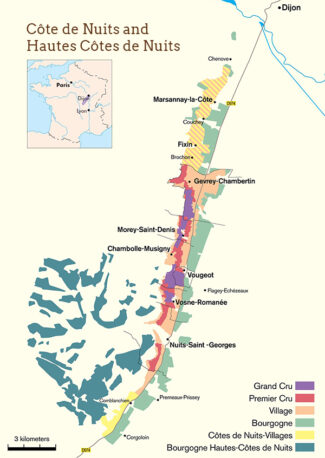
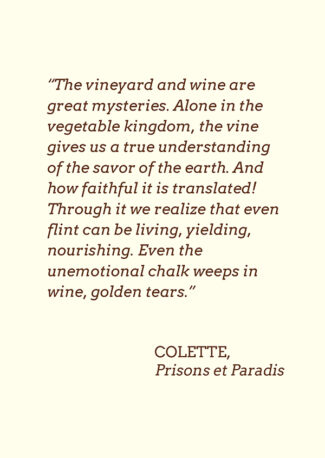
| The northern half of the escarpment of the Côte d’Or is called the Côte de Nuits, and it marks the area that produces Burgundy’s most highly regarded red wines. The best vineyards are found in a narrow band of limestone with south-east exposures into order to maximize sunlight in an otherwise cool climate.
The lower-lying vineyards contain more clay and drain less well, producing generic wines often labeled Bourgogne Rouge, or occasionally Bourgogne Passtoutgrains, which may contain Gamay. Markedly superior are the communal wines labeled Côte de Nuits-Villages, usually Pinot Noir-based wines produced in the smaller villages of Fixin, Brochon, Prémeaux, Comblanchien and Corgoloin.
The most prestigious village wines carry as their appellation the name of the village in which they were made. Running from north to south, the principal villages of the Côte de Nuits are Gevrey-Chambertin, Morey-Saint-Denis, Chambolle-Musigny, Vougeot, Vosne-Romanée, Flagey-Échézeaux, and Nuits-Saint-Georges. |
|
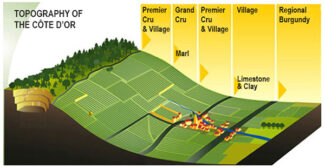
| With the village of Nuits-St-Georges itself as the fulcrum, the robust appellation extends to the north as far as the border of Vosne-Romanée, while the southern section lies partly in Nuits-Saint-Georges and partly in Prémeaux. The wines from each section are unique in style and according to experts, with differences defined (in the main) by the lay of the land. The soils in the northern sector are built around the pebbly alluvium that washes down from up-slope, or in the low-lying parts, around silty deposits from the river Meuzin. In the southern sector the alluvia at the base of the slopes originate in the Combe des Vallerots where there are deep marly-limestone soils, while at the top of the slope, the soil has nearly all eroded away and the rock is near the surface. In both regions, favored exposures are mostly to the east or southeast.
Producing predominantly red wine, Nuit-Saint-Georges bottles display the muscularity and breeding most sought after in Burgundy—the ability to improve with bottle age. When young, the wine display aromas of cherry, strawberry and blackcurrant, and when matured, leather, truffle, fur and game. |
|
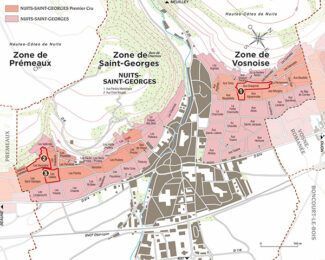
Burgundy 2015
An ‘Extraordinary’ Vintage: Rich, Powerful and Statuesque
|
|
| 2015 was an extraordinary year throughout the Côte d’Or—for red wines in particular, since there was some uneven ripening among the Chardonnay vineyards. Of 2015 vintage in the Côte de Nuits, Bruno Clair (of Domaine Bruno Clair) describes 2015 as ‘an aristocratic vintage with finesse.’
It was not, however, a copious harvest: A series of hot nights in June and July caused grapes to drop, reducing yields, and those that remained were small with concentrated juice. The critical factor appears to be the climactic star-alignment that allowed the grapes that remained on the vine to remain so healthy that sorting was not required. Michel Lafarge of the eponymous domain, draws parallels between 2015 and 1929. “No other vintage in the past 60 years,” he insists, “is really comparable.”
That said, this a big-shouldered vintage where the tannins reached optimal maturity along with the ripeness of the fruit. They are wonderfully expressive today, but should continue to evolve for many years to come. |
|
| Slow evolution is a hallmark of the Alain Michelot philosophy. With twenty acres of vines, nearly all in Nuits-Saint-Georges and half of them Premier Crus, they have slipped under the radar of wine media attention, especially in the United States—despite Matt Kramer’s unbridled praise in ‘Making Sense of Burgundy.’ |
|
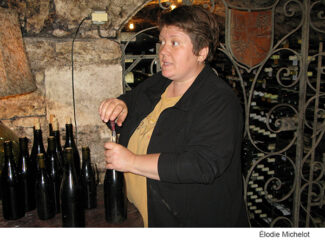
| Change happens gradually at Domain Alain Michelot, and only in increments, methodically and rationally. But the significant shift at the top happened when Alain retired as winemaker and was succeeded by his daughter, the poetically named Élodie Michelot. Her touch has been delicate and judicious; slightly smaller yields, slightly less oak employed. As always, the grapes are 90% destalked, and cuvaison lasts around three weeks. After pressing, the must settles for a good month—a process known as ‘debourbage’—and only then is transferred to Allier and Limousin barrels. The age of the wood depends on the vintage, but is roughly a third new oak. There is no racking for the next 20 months, resulting in very fine tannins, and, as is the tradition in Nuits-Saint-Georges, the wines are bottled lightly filtered, but not fined. |
|
Zone de Vosnoise (the northern end)
|
|
| Often referred to as Zone Vosnoise, this region represents the northern end of Nuits-Saint-Georges, a mere chunk of Prémeaux limestone’s throw away from ‘La Tâche.’ The best terroir layers thin soil with pebbles, cobbled silts from the coast, clay and scree, and the preeminent domains produce rich and opulent Pinot Noirs that tend to be more fruit forward and elegant than their southern counterparts. |
|
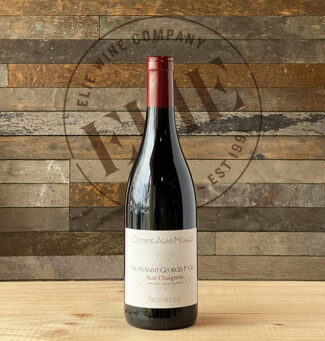 (1) 2015 Nuits-Saint-Georges Premier Cru Aux Chaignots ($102)
(1) 2015 Nuits-Saint-Georges Premier Cru Aux Chaignots ($102)
Aux Chaignots is a fifteen-acre climat that is wonderfully representative of Zone Vosnoise, located at mid-slope with an eastern exposure and overlaying stone and chalk soils. With Les Damodes, Aux Vignerondes and Aux Bousselots Premier Crus as its neighbors, superior drainage encourages a deep root system for the vines to access water and those nutrients that only exist further down in the ground. The vineyard’s exposure works in tandem with its position on the slope, offering plentiful sunlight for ripening throughout the growing season and enough elevation to provide a diurnal temperature variation.
Discreet wood sets off Domaine Alain Michelot’s spicier aromas and enhances the background floral nuances. The mouthfeel is pure and precise with layers of dark cherry, Damson plum and a confit-like finish with wonderful definition and superb length.
Zone de Saint-Georges (central)
|
|
| The middle zone of Nuit-Saint-Georges is relatively small, with elevations that do not exceed one thousand feet. It extends from the village of Nuits-Saint-Georges, running from northeast to southwest, and the geological backbone is limestone, both in the wine craft and in commercial excavation. Quarries dot the entire zone. |
|
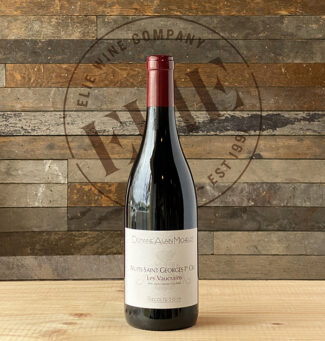 (2) 2015 Nuits-Saint-Georges Premier Cru Les Vaucrains ($110)
(2) 2015 Nuits-Saint-Georges Premier Cru Les Vaucrains ($110)
Les Vaucrains is perhaps the most highly regarded Premier Cru vineyards in the Nuits-Saint-Georges appellation, and in the absence of Grand Cru vineyards, this is considerable praise. A bit more than fifteen acres in size, the climat sit on the steep, upper slope of the Côte d’Or, just below the line on the famous escarpment where vineyard becomes forest. The Premier Cru vineyards of Les Chabœufs and Chaines Carteaux lie to the north and south respectively.
The vineyard’s position means that the soils are calcareous and rocky, as erosion has sent much of the finer material down the hill. The lack of water in the free-draining soil makes for concentrated berries, and a small amount of clay contributes weight to the finished wine, which offers up superb purity and complexity, a mix of red and black cherries, wood smoke above a solid base of soil tones and oak vanilla.
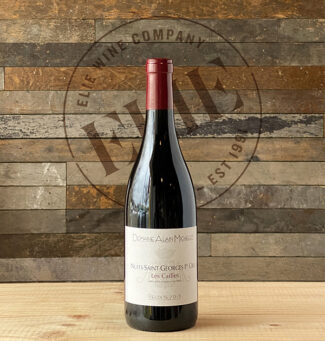 (3) 2015 Nuits-Saint-Georges Premier Cru Les Cailles ($102)
(3) 2015 Nuits-Saint-Georges Premier Cru Les Cailles ($102)
Les Cailles is a highly-regarded Premier Cru that lies between the Les Saint-Georges and Les Porrets-Saint-Georges climats. Although there are no classified Grand Crus in Nuits-Saint-Georges, this landscape, south of the Nuits-Saint-Georges township and about halfway between there and the neighboring village of Prémeaux-Prissey, is considered by many to be worthy of the status.
The vineyard’s mid-slope position is perfectly angled to take advantage of the morning sunlight; as it rolls gently toward the east, the vines bask in light for a good portion of the day. The soil below is pebbly and sandy, and the climat earns its name from these small stone—‘callou’ is French for pebble.
The wine is explosively precise, with delicate violet petals scents filtering through black cherry and warm raspberry and leading into lithe tannins. The satin texture and a harmonious finish echo dark fruit and smoky spice.
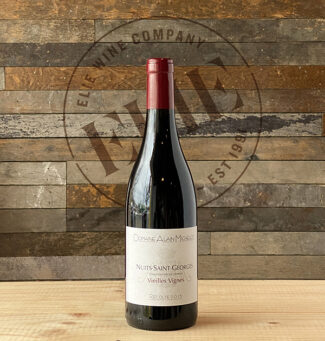 (4) 2015 Nuits-Saint-Georges ‘Vieilles Vignes’ Village ($75)
(4) 2015 Nuits-Saint-Georges ‘Vieilles Vignes’ Village ($75)
Two vineyard sites supply the grapes for this old vine cuvée, one in the southern part of the village with vines ranging from 65 and 77 years old, and another in Prémeaux-Prissey, where vines were planted fifty years ago.
Complex and rich on nose and palate, the wine shows the exotic qualities of vine age; potent black cherry, sweet black olive tapenade, tart crab apple and strawberry pie between more subtle anise and mint notes, with mature, salty, black licorice notes on the finish.
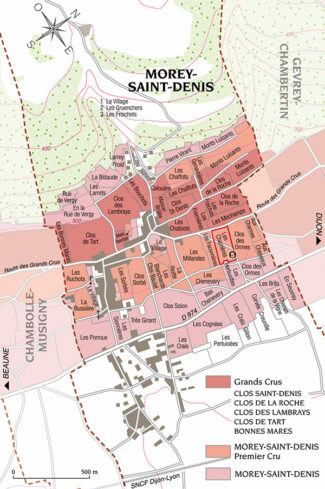
| Forming a stylistic bridge between the firm, fleshy wines of Gevrey-Chambertin and the perfumed wines of Chambolle-Musigny, Morey-Saint-Denis is a wealth of Crus, including twenty Premier Crus and five Grand Crus: Clos de Tart, Bonnes-Mares, Clos de la Roche, Clos Saint-Denis and Clos des Lambrays. The best sites are planted on thin, well-drained, oolitic limestone soils that date from the Middle Jurassic, and occupy the middle slopes, while lesser quality wines are produced on the highest and lowest elevations. |
|
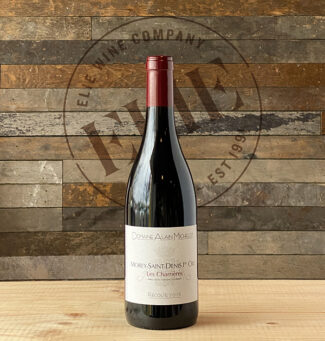 (5) 2015 Morey-Saint-Denis Premier Cru Les Charrières ($93)
(5) 2015 Morey-Saint-Denis Premier Cru Les Charrières ($93)
Les Charrières lies just below the famed Clos de la Roche Grand Cru appellation, and is planted entirely to Pinot Noir. The climat’s east-facing position at the bottom of the slope gives the vines a gentle angle toward the rising sun, helping the vines to develop sugars and phenols in the cool Burgundian climate. Smaller than six acres in size, few wines are made under this designation, which is a shame since the terroir is not dissimilar to its renowned neighbor upstairs. Soils are shallow marly limestone, free draining, encouraging vines to work hard for water reserves and produce high-quality grapes.
Supple and harmonious, the wine is backed by moderately firm tannins supporting black cherry, earth and toasted spice flavors with a developing profile showing truffle, chocolate, rich leather and a silky, lingering and attractively textured finish.
. . . AND ADD
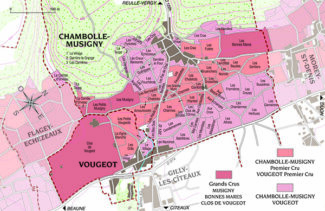
| The Vougeot commune should be distinguished from its most famous vineyard, Clos Vougeot, since it also encompasses several other fine climats (three of which are Premier Crus) and has a reputation for excellent white wines as well as reds—rather unusual for the Côte de Nuits. Even red wines from the tiny appellation are allowed to add up to 15% ‘accessory’ varieties, Chardonnay, Pinot Blanc or Pinot Gris.
Deriving its name from the small Vouge river, Vougeot (both the Clos and the satellite climats) owes its reputation to the powerful abbey of Cîteaux, who established these vineyards in the 12th century. The best wines of Vougeot are among the most masterful in Burgundy, succulent and mellow allowing a seamless balance between elegance and delicacy and meaty fullness. |
|
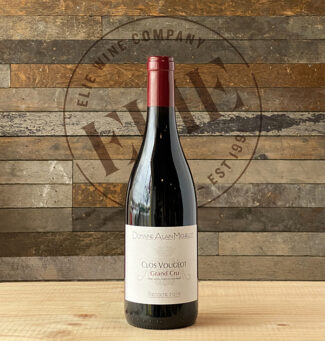 2015 Domaine Alain Michelot Clos Vougeot Grand Cru ($198)
2015 Domaine Alain Michelot Clos Vougeot Grand Cru ($198)
In fact, despite the existence of other Premier Cru sites in the commune of Vougeot, the Clos takes up most of the vineyard space and nearly all the glory, and are in good company: The slopes at the upper end of the Clos abuts the vineyard of Grand Cru Grands Echézeaux.
A Burgundian icon, Clos Vougeot sits 800 feet above sea-level, with its gently-sloping upper reaches consisting of shall soil only a few inches deep; it is coarse-grained and gravelly and lies over a limestone base. In the center portion of the vineyard, soil depth increases, but only slightly, becoming brown with clay and overlaying broken limestone. The lowest portion of the climat contains soil up to two feet deep and is built on layers of marl which are rich in clay and alluvium.
Musky and potent with cherry cordial, wild herbs and smoky minerality, of dark cherry, wild herbs and smoky minerality, the 2015 Domaine Alain Michelot Clos Vougeot is concentrated and sweet, with pronounced soil tones blending within pronounced flavors of underbrush and roasted meat; finishing juicy and very long with finely-grained tannins.
- - -
Posted on 2022.02.14 in Côte de Nuits, Morey-Saint-Denis, France, Burgundy, Wine-Aid Packages





 (1) 2015 Nuits-Saint-Georges Premier Cru Aux Chaignots ($102)
(1) 2015 Nuits-Saint-Georges Premier Cru Aux Chaignots ($102) (2) 2015 Nuits-Saint-Georges Premier Cru Les Vaucrains ($110)
(2) 2015 Nuits-Saint-Georges Premier Cru Les Vaucrains ($110) (3) 2015 Nuits-Saint-Georges Premier Cru Les Cailles ($102)
(3) 2015 Nuits-Saint-Georges Premier Cru Les Cailles ($102) (4) 2015 Nuits-Saint-Georges ‘Vieilles Vignes’ Village ($75)
(4) 2015 Nuits-Saint-Georges ‘Vieilles Vignes’ Village ($75)
 (5) 2015 Morey-Saint-Denis Premier Cru Les Charrières ($93)
(5) 2015 Morey-Saint-Denis Premier Cru Les Charrières ($93)
 2015 Domaine Alain Michelot Clos Vougeot Grand Cru ($198)
2015 Domaine Alain Michelot Clos Vougeot Grand Cru ($198)


